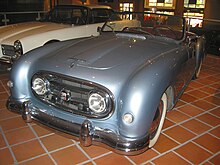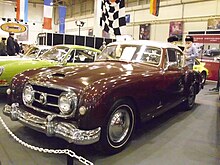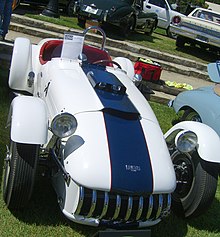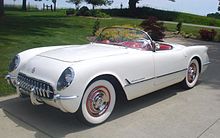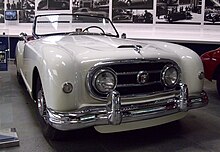Nash-Healey
Nash-Healey was a British - American automobile brand that manufactured luxury sports cars from 1951 to 1954 . The vehicles were from the Donald Healey Motor Company in Warwick , Warwickshire , England , designed and manufactured to the marketing done by Nash Motors .
Donald Healey had founded his automobile factory in 1946 and specialized in the production of Gran Turismo , sports cars and racing cars in small numbers and had earned a good reputation for this. Healey was quite successful in endurance races and had a competitive racing car in its program, the Healey Silverstone .
Emergence
Company boss Donald Healey traveled to the United States in 1949 with his son, racing driver Geoffrey Healey , to advertise his cars and look for more powerful engines; so far he used the larger four-cylinder engines from the manufacturer Riley , as they were also used in its RM series (2443 cm³). Only for the 3 liter did he fall back on the six-cylinder engine from Alvis , an OHV engine with a displacement of 2993 cm³. The output of the two engines 104 bhp or 77.6 kW with Riley engine, respectively. 106 bhp or 79 kW with an Alvis engine was comparable.
In 1949 Cadillac brought out a groundbreaking new OHV V8 engine with 5424 cc (330.9 ci) and 160 bhp (117.76 kW).
The very wealthy American racing driver Briggs Cunningham ordered a custom-made Silverstone with this engine from Healey . Due to the impressive driving performance, Donald Healey planned to produce a small series of this car. Therefore, the Healeys wanted to use their stay in the United States to negotiate with Cadillac about the delivery of engines. They weren't averse there, but the deal didn't come off because Cadillac's parent company General Motors intervened and prohibited delivery. The reasons for this are unclear; a number of other companies such as Allard in Great Britain and Kurtis or Muntz (1951 only) in the United States used them.
On the return journey on the passenger ship RMS Queen Mary , the Healeys accidentally met George W. Mason , the president of the Nash Kelvinator Corporation and thus the manufacturer of the Nash automobile. This was ready to provide engines, manual Borg-Warner three-speed transmissions , cardan shafts and differentials for Healey .
A contract to this effect was signed when the ship arrived. Mason also wanted to sell the new sports car through its own dealer network, because Nash had no sporty model and no image carrier to offer. For Healey, of course, this made sales much easier in the United States, even if he wasn't allowed to bring out the car under his own name and had to make concessions in design.
technology
engine
Healey first time set a series -Sechszylindermotor in Le Mans in 1950 a; at that time the chassis of a Healey Silverstone had been modified accordingly. Nash and Healey agreed to deliver the Dual Jetfire Six with dual ignition which was also offered in the Nash Ambassador . The two-valve engine with OHV valve control had a displacement of 3845 cm³ (234.6 ci); Bore × stroke were 85.70 × 111.10 mm. The engine also had mechanical lifters, a compression ratio of 7.3: 1, a single carburetor and an output of 115 bhp @ 3400 / min (86 kW). At Healey, however, this engine was revised: It received a "sharper" camshaft , instead of the cast iron cylinder head one made of aluminum , with which the compression could be increased to 8: 1, and two SU carburettors instead of the simple single carburetor. This enabled a stable increase in performance to 125 HP @ 4000 / min (93 kW). The Nash factory code for the car was 25162. No engine options were offered at the factory. However, some owners took advantage of the generous space and installed V8 engines from other manufacturers, such as Cadillac .
chassis
The chassis of the Nash-Healey (Type N) is derived from that of the Healey Silverstone (Type E). Like all Healey chassis, it was designed by AC Sammpietro . In order to offer more comfort, it was designed a little wider and also reinforced for the significantly heavier engine. It consists of a box frame made of (18- gauge sheet steel) with cross struts. The front axle developed by Sammpietro, typical for Healey, with a swing arm independent wheel suspension , two crank trailing arms and a corner stabilizer was also used, including the patented steering. This is based on the principle of a rotating plate and a steering linkage, which transmit the forces from the steering gear to the wheels. The Silverstone's rear leaf springs have been replaced with coil springs. Depending on the source, a rear axle from Nash resp. Salisbury used. It was conducted on a Panhard staff. The vehicle also received hydraulic support from Bendix ("TreadleVac") for the drum brakes , which is important for the US market . The Roadster has a wheelbase of 102 inches (2591 mm), the track in front and behind each 1346 mm (53 inches); At the rear it was widened to 1397 mm (55 inches) from 1952. Steel wheels with plain chrome wheel caps were fitted at the factory; the tire size was 6.40 × 15. Spoked wheel caps were later optional.
Because the Nash-Healey was intended for sale in the United States, the vehicles were built with left-hand drive. There is an indication that a single vehicle may have been right-hand drive, but the VIN number G525 on it indicates a Healey 3 liter (Alvis-Healey) . Nash-Healey use the letter "N" as the first position of the number; Alvis-Healey "G".
1951: first series
body
The car was given a roadster body with formal similarities to the earlier Healey Sportsmobile and 3 liter (Alvis-Healey) . Healey designer Benjamin Bowden contributed the design, and the bodywork was supplied by Panelcraft Sheet Metal Company in Woodgate , Birmingham . Like all Healey factory bodies, these were also handcrafted from aluminum. It is the only Healey construction that lacks the typical diamond-shaped radiator grille as Healey's identification mark; Mason insisted on the use of a Nash radiator grille to underline the brand affiliation, after all, the Nash-Healey was primarily intended as an image carrier.
Panelcraft completed the bodies in a single series at the beginning of 1950, so that they only had to be called up. 30 additional bodies were produced for the Healey 3 liter (Alvis-Healey) ; outwardly, these differed mainly in a different front. Final assembly took place at Healey in Warwick, taking care to use small Nash parts to simplify maintenance. The interior was high quality and included leather trim and an adjustable steering wheel. Overdrive, cigarette lighter and whitewall tires completed the basic equipment. The car weighed 1179 kg and was therefore not an extraordinarily lightweight by the standards of the time.
Production and equipment
The transport routes resulting from the production processes used are the main reason for the skyrocketing costs for the sports car: Nash delivered its components to Healey in Warwick, where the chassis was built and the parts were installed by Nash. Completed to "Rolling Chassis", these were sent to Panelcraft in Birmingham . There they received the body and interior fittings and then went back to Healey for the final assembly and final acceptance mentioned above. Because most of the Nash-Healey were sold in the United States, they still had to cross the Atlantic.
Launch
The prototype of the Nash-Healey was shown at the automobile shows in London and Paris in 1950, and vehicle production itself began in December 1950. 36 cars had been completed by the end of the year. The official presentation took place at the automobile exhibition in Chicago in early 1951. A further 68 Nash-Healey were built by the end of March 1951. / So a total of 104 examples of the 1st series were built.
Officially, only the colors Champagne Ivory (ivory) and Sunset Maroon (wine red) were available. Healey may have shipped the vehicles at Champagne Ivory believing that color would be well received in the United States; Once in the United States, Nash repainted them on Sunset Maroon . This subsequent change to the color scheme could explain why some specimens have also got a lime green color.
The biggest obstacle to success was price: a list price of US $ 3767 to US $ 4063 was not competitive.
Second series
1952: Pininfarina
Pininfarina in Turin had been commissioned by Nash to compete with the in-house styling department headed by Edmund Anderson to make suggestions for the lines of the upcoming models; some details like the radiator grille were taken over; the rest came from Nash. Even so, Pininfarina advertised Nash (and herself, of course) in the 1952 Nash sales brochure.
In this environment, Nash asked Pininfarina for a revision of the Nash-Healey Roadster. He also received the order to manufacture the body. At Healey there was a production interruption from April 1951 to January 1952 and a delayed introduction of the 1952 model; During this time production was set up in Turin. Pininfarina no longer built the bodies from aluminum, but from sheet steel; only the bonnet , trunk lid and doors were made of light metal. The weight increased to 1247 kg. One of the few changes to the chassis was a slightly wider rear track .
Although the car looked sportier, the new lines were received somewhat ambiguously. The front with the headlights moved inwards was typical of the Nash design and was just as controversial at the Nash Healey as it was there. The hubcaps carried imitation spokes upon request. After all, in 1953 a Nash-Healey won an international Concours d'Elegance in Italy in its class. Nash no longer called the vehicle a roadster , but a Convertible ( Cabriolet ), and gave it the factory code 25262 .
From February 1952 until the end of the model year, Pininfarina built 150 Series 2 roadsters with the 3.8 liter engine at a list price (US $ 5908) that was the equivalent of two well-equipped mid-range cars. After all, the chassis were now sent to Turin instead of Birmingham and came more or less completely back to Warwick for final assembly and acceptance.
1953: Roadster and Coupé
There were hardly any changes for the Roadster (factory code 25362. Pininfarina also built a two-seater coupé variant called Le Mans with a panoramic rear window on a slightly longer wheelbase of 2743 mm (108 inches). It received the Nash factory code 25367 In view of the modest sales figures and the planned merger with the Hudson Motor Car Co. to form the American Motors Corporation in 1954, the 1953 model was built longer than usual, and from February the latest version of the engine, called the Le Mans Dual Jetfire Six, became available with a larger displacement of 4138 cc (252.5 ci). Ex-works this engine delivered 130 bhp (95.7 kW) at 3700 rpm. After the usual treatment by Healey, the compression increased from 7.6: 1 to 8: 1 and the power to 140-142 bhp (104.5 kW) at 4000 rpm.
Because of the bad sales figures, the model year was extended. For this year it is only known that 162 Nash-Healey were built, but not how many were built in which of the four versions:
- Roadster; 3.8 liters (until February 1953)
- Coupe; 3.8 liters (until February 1953)
- Roadster; 4.1 liters (from February 1953)
- Coupe; 4.1 liters (from February 1953)
The price was now, depending on the source, at US $ 5908, - resp. over US $ 6400, - which was unacceptable, although the Nash-Healey was one of the few automobiles that was both easy to drive in everyday life and could win on a racetrack at the weekend.
1954-1955
The "new" Nash-Healey only appeared on June 3, 1954, after the merger of Nash with Hudson. The roadster was no longer offered. Instead of the one-piece, the coupé was given a three-piece rear window and the factory code 25467 . All had the larger engine with 4.1 liter displacement.
The restriction to the coupe also lifted the Nash-Healey from the Chevrolet Corvette, which was presented in 1953 and is now on the market . Although Nash lowered the list price to US $ 5128, it was still not competitive with the Corvette at US $ 3513.
At the end of the 1954 model year, a few Nash-Healey remained unsold. Nash recoded them to 1955 chassis numbers and referred to them as new models; a not uncommon practice at that time, which is also known from Kaiser , for example . A total of 90 coupés from both “model years” were created.
After the merger to form the AMC, production of the Nash-Healey was quietly ended. The decision was easy because the largest merger in US industrial history to date generated enough publicity and Donald Healey closed his company in the same year anyway in order to produce the Austin Healey with Austin .
Production numbers
The following compilation results from the above production figures:
| Model year | production |
|---|---|
| 1951 | 104 |
| 1952 | 150 |
| 1953 | 162 |
| 1954-1955 | 90 |
| Total | 506 |
This total is not confirmed by all sources. Without breaking down the number exactly, other sources give different production figures; about 504 and 507, respectively.
Market situation and competitors
The small number of units can be explained by the extraordinarily high price of the Nash-Healey; a brand-new family car cost around US $ 1,800 in 1953, a mid-range sedan between US $ 2,400 and US $ 2,800.
Sports cars hardly played a role in US production in the early post-war period. They managed to import mainly British roadsters, often brought back in used condition by returning GIs . British manufacturers preferred to supply the US market - often before their own - with new models in order to improve the foreign trade balance with foreign exchange ; Vehicles like the Austin Atlantic or the Jaguar XK 120 were designed primarily for the US market. The US auto industry was reluctant to take the risk of introducing offers for this niche market that could compete with the British and Italian sports car manufacturers in terms of price.
In addition to the Nash-Healey, there were three other manufacturers in the United States with a significant sporting history, which could fall back on the chassis of a renowned racing car designer. One was Cunningham with the extremely expensive and low- volume C3 ; the coupe version cost an astronomical US $ 11,422.50. Cunningham was quite successful at the Le Mans 24 Hours at the time . The others were the technically closely related ones ( Kurtis 500 S, 500 KK and 500 M ) and the Muntz Jet . All of them go back to Frank Kurtis ' victorious Indianapolis 500 design and offered V8 engines from various manufacturers at prices comparable to the Nash-Healey. The Kurtis 500 S was a racing version with "motorcycle" fenders, the 500 KK came as a chassis and had to be body-built and the 500 M was its completed variant. The Muntz Jet is an elongated, five-seat version of the Kurtis 500 M and cost around US $ 5500.
The Edwards , built between 1953 and 1955, with its powerful V8 engine could have become a competitor, but no series production came about.
Buyer alternative dream cars?
So only a very few US vehicles were charged a similarly high price as a Nash-Healey . An alternative to these pure sports cars were the “Sports Convertibles” called “ Motorama Dream Cars” from General Motors and the also new Packard Caribbean ; Although they were designed to be less sporty, they all had much more powerful eight-cylinder engines:
- Cadillac Eldorado ; List price 1953 US $ 4737, 7750 examples built.
- Buick Skylark ; List price 1953 US $ 4,260; 1954 US $ 4,483th edition. 1953: 5000 copies.
- Oldsmobile Fiesta ; Listed price 1953 $ 5717, discontinued thereafter
- Packard Caribbean ; List price 1953 US $ 5210; 1954 US $ 6100.
The Oldsmobile weighed just under two tons, accelerated from 0 to 60 MPH (96 km / h) in about 12 seconds and was over 100 MPH (160 km / h).
More affordable sports cars from 1953
Also in 1953, the Chevrolet Corvette C1 was an equivalent US sports car. In its first year it was only available to a limited extent (only 315 copies were built and preferably sold to “image carriers”). As early as 1954, however, 3640 Corvettes were already sold - at prices from US $ 3513.00 (1953) resp. US $ 3,523.00 (1954).
In the following year several new sporty cars appeared. The little Hudson Italia had a six-cylinder engine with 3303 cm (201.6 ci) and 114 bhp (85 kW). At a price of (depending on the source) US $ 4,350 to US $ 4,800, the coupé built on the chassis of the compact Hudson Jet did not even come close to offering the driving characteristics of the Nash-Healey ; the jet was designed as a comfortable touring car and the Italia was too heavy for the engine used , despite its aluminum body built by Carrozzeria Touring in Milan. Only 25 copies plus prototypes were built by 1955, when both Jet and Italia had disappeared from the market.
The Emperor Darrin lasted a little longer. He too had to get by with the chassis of a compact car (that of the Emperor Henry J , and his Willys six-cylinder with 2638 cm³ (161 ci) had been increased from 80 bhp (60 kW) to 90 bhp (67 kW) as standard Performance was offset by the significantly lower price (from US $ 3668, -) and the lightweight GRP body. The design took some getting used to, but offered innovative ideas such as a hood that could also be used half open and, above all, sliding doors in the body disappeared.
The greatest novelty was undoubtedly the Ford Thunderbird . Presented for the 1955 model year, it was not a thoroughbred sports car, but its chic appearance combined with the powerful V8 engine (193 bhp or 144 kW; with automatic transmission 198 bhp or 147 kW) and a comparatively low price of US $ 2944, - made him an instant hit.
Nash-Healey at Le Mans
The Healey brand has had a brief but quite successful racing career since 1946, the year it was founded. A great success was the 4th place in the 24-hour race of Le Mans in 1950 for the Tony Rolt / Duncan Hamilton team with a Silverstone Special with the 3.8 liter Nash six-cylinder engine similar to the later production version. In this race, out of 66 cars that started, only 29 even crossed the finish line.
In 1951 , the team with the same drivers and a new coupé (start number 19) achieved class victory and finish 6th, but it was so late that there was hardly any time for training. With the Aston Martin ahead of them, the Nash-Healey fought a gripping final duel; at the finish he was within eight seconds.
The greatest success was the third final place of the British Leslie Johnson and Tommy Wisdom at Le Mans in 1952 with a new Barchetta (start number 10) behind two Mercedes-Benz 300 SLs but ahead of the works teams of Ferrari , Aston Martin Jaguar , Lancia , Talbot -Lago , Porsche , Osca and others. At the same time they came second in their class, second in the Rudge-Withworth Biennial Cup for best performance in two consecutive years and won the Motor Gold Challenge Cup . Donald Healey later said that apart from an exhaust (repaired on site) the car had no technical problems and did not use a drop of oil! Fourth-placed Cunningham with a Chrysler -V8 was 80 miles (approx. 130 km) behind. A second Nash-Healey with starting no. 11 of the French Pierre Veyron and Yves Giraud-Cabantous was considered faster, but did not finish.
In 1953 , John Fitch should have taken over one of the Nash Healey , but he switched to Cunningham , so Leslie Johnson and Bert Hadley (GB) formed a team. They finished in 11th place. Veyron / Giraud-Cabantous were again among the 35 of 60 vehicles that did not make it to the finish . The race winners were two former Nash-Healey works drivers, Rolt / Hamilton in a Jaguar .
Nash-Healey in the model
- 1950 Nash-Healey, Le Mans 1950 (Rolt / Hamilton; 4th place); Provence Moulage No. 366; 1:43 scale ( resin kit)
- 1951 Nash-Healey Coupé, Le Mans 1951 (Rolt / Hamilton; 6th place); Bizarre 43 Art. BZ090; 1:43 scale (finished resin model)
- 1952 Nash-Healey "Lightweight" Barchetta, Le Mans 1953 (Johnson / Wisdom; 3rd place); Bizarre 43; Scale 1:43 (finished resin model, see Fig.)
- 1953 Nash-Healey Roadster Pininfarina, white; Brooklin Models No. 125; 1:43 scale (white metal finished model)
- 1953 Nash-Healey Coupé Le Mans Pininfarina; Signature Models No. 32332; 1:32 scale (die-cast finished model, hoods and doors open)
Others
- The first delivered Nash-Healey went to the singer Petula Clark
- SC Johnson & Son bought a Nash-Healey Roadster in 1951 and had it rebuilt as a one-off by William Flajole , the designer of the later Nash Metropolitan . The car was the subject of a US-wide auto wax advertising campaign with baseball player Ted Williams .
- In the television series Superman - Savior in Need (English. Adventures of Superman ; 1952-1958) the actor from Superman / Clark Kent , George Reeves , occasionally drives a Nash-Healey. This car belonged to film actor Dick Powell .
- In the movie Sabrina (1954) with Audrey Hepburn , Humphrey Bogart and William Holden a Nash-Healey appears
literature
- Roger Gloor: Post War Car. 2nd Edition. Hallwag AG, Bern / Stuttgart 1981, published by Automobil Revue. ISBN 3-444-10263-1 .
- David Culshaw, Peter Horrobin: The Complete Catalog of British Cars 1895-1975. Veloce Publishing PLC, Dorchester 1997, ISBN 1-874105-93-6 . (English)
- Consumer's Guide (Ed.): Encyclopedia of American Cars from 1930. Publications International, 1993, ISBN 0-7853-0175-5 . (English)
- GN Georgano (Ed.): Complete Encyclopedia of Motorcars, 1885 to the Present. 2nd Edition. Dutton Press, New York 1973, ISBN 0-525-08351-0 . (English)
- Tad Burness: American Car Spotter's Guide, 1940-65. Motorbooks International, ISBN 0-87938-057-8 . (English)
Web links
- GTÜ Society for Technical Monitoring: Nash-Healey. (accessed on May 30, 2017)
- healey-classic.de: Website about Healey Silverstone and Sportsmobile. (accessed on May 30, 2017)
- Memento: ridedrive.co.uk: Classic Healey Cars. ( Memento of March 6, 2016 in the Internet Archive ) (accessed on May 30, 2017)
- Nash Car Club; Nash-Healey (accessed May 30, 2017)
- americansportscars.com: Nash-Healey. (English, accessed May 30, 2017)
- Association of Healey Owners: website. (English, accessed May 30, 2017)
- Dan Lyons: Cars of the Fantastic '50s . Ed .: Tom Collins. Krause Publications, 2005, ISBN 0-87349-926-3 (English, limited preview in Google Book Search [accessed January 13, 2017]).
- carfolio.com; Healey Automobile Specifications (accessed May 30, 2017)
- carfolio.com; Specifications for the models 1950, 1952 and 1953 (accessed May 30, 2017)
- Jeremy Wilson: Popular Restorations; History and Production Notes (accessed May 30, 2017)
- The Old Car Manual Project: Nash Golden Airflyte Sales Catalog 1952 (accessed May 30, 2017)
- The Old Car Manual Project; Nash-Healey sales catalog 1953 (accessed May 30, 2017)
- How Stuff Works (Consumer Guide); Nash-Healey (accessed May 30, 2017)
- Anamera: 1951 Nash Healey Roadster, s / n N333967; 1953 Cadillac V8 conversion. (English, accessed May 30, 2017)
- Richard M. Kauffman: Special Interest Auto No. 1 (1970) pp. 45-52: Nash-Healey at Le Mans. (English, accessed May 30, 2017)
- conceptcarz.com: 1950 Nash Ambassador Airflyte . (English, accessed May 30, 2017)
- conceptcarz.com: 1951 Nash-Healey "Le Mans" . (English, accessed May 30, 2017)
- conceptcarz.com: 1949 Cadillac Series 62. (accessed May 30, 2017)
- conceptcarz.com: 1953 Cunningham C3 Continental. (English, accessed May 30, 2017)
- conceptcarz.com: 1953 Cunningham C5R. (English, accessed May 30, 2017)
- conceptcarz.com: 1951 Nash-Healey "Le Mans" . (English, accessed May 30, 2017)
- conceptcarz.com: 1952 Nash-Healey "Le Mans" . (English, accessed May 30, 2017)
- conceptcarz.com: 1953 Nash-Healey "Le Mans" . (English, accessed May 30, 2017)
- conceptcarz.com: 1950 Nash Ambassador Airflyte . (English, accessed May 30, 2017)
- conceptcarz.com: 1954 Nash Ambassador . (English, accessed May 30, 2017)
- packardinfo.com: 1953 Packard Clipper Touring Sedan. (English, accessed May 30, 2017)
- Movie "Sabrina" (1954) at imcdb.org (accessed May 30, 2017)
Remarks
- ↑ Another representation can be found on the discussion page.
- ↑ z. B. Chevrolet Two-Ten as a four-door sedan from the middle of three series, US $ 1761 (Consumer's Guide: Encyclopedia of American Cars from 1930 , p. 191)
- ↑ z. B. Packard Clipper Touring Sedan, from US $ 2588 (packardinfo.com; Packard Clipper Touring Sedan 1953)
- ↑ According to SIA 1/70 class victory in class 3001-5000 cm³.
Individual evidence
- ↑ a b c Gloor: Post-war car. 1981, pp. 178-179.
- ↑ a b Culshaw, Horrobin: Complete Catalog of British Cars 1895-1975. 1997, p. 152.
- ↑ a b c healey-classic.de: Website about Healey Silverstone and Sportsmobile.
- ^ A b Association of Healey Owners: Web site. (English, accessed May 30, 2017)
- ↑ carfolio.com: Standard Specifications 1946 Healey Elliott.
- ↑ carfolio.com: Standard Specifications 1951 Healey Alvis.
- ↑ carfolio.com/specifications; Cadillac 1951
- ↑ conceptcarz.com: 1949 Cadillac Series 62nd
- ↑ a b americansportscars.com: Nash-Healey.
- ↑ Consumer's Guide: Encyclopedia of American Cars from 1930. 1993, p. 814 (Kurtis).
- ↑ a b c Consumer's Guide: Encyclopedia of American Cars from 1930. 1993, p. 587 (Muntz).
- ↑ a b ridedrive.co.uk: Classic Cars Healey; "Donald Healey Travels to The United States."
- ↑ a b c d e f g h i j k l Special Interest Auto No. 1 (1970), pp. 45–52: Nash-Healey in Le Mans.
- ↑ conceptcarz.com: 1950 Nash Ambassador Airflyte.
- ^ A b c d e Nash Car Club of America (NCCA): website.
- ↑ a b c Anamera: 1951 Nash Healey Roadster, s / n N333967; 1953 Cadillac V8 conversion.
- ↑ ridedrive.co.uk: Classic Cars Healey; "The Chassis."
- ↑ carfolio.com: Standard Specifications 1950 Nash-Healey.
- ↑ ridedrive.co.uk: The Nash-Healey Launch in Paris.
- ^ A b c d e conceptcarz.com: 1951 Nash-Healey.
- ^ Howstuffworks: Nash-Healey.
- ^ The Old Car Manual Project: Nash Golden Airflyte sales catalog 1952.
- ↑ a b c d e f conceptcarz.com: 1952 Nash-Healey.
- ↑ carfolio.com: Standard Specifications 1952 Nash-Healey.
- ↑ a b c d e conceptcarz.com: 1953 Nash-Healey.
- ↑ a b c d Jeremy Wilson: Popular Restorations; History and Production Notes at popularrestorations.com
- ↑ a b c d Dan Lyons: Cars of the Fantastic 50s. MBI Publishing, 2005
- ↑ conceptcarz.com: 1954 Nash Ambassador.
- ↑ a b c Consumer’s Guide; Encyclopedia of American Cars from 1930. pp. 593-594.
- ^ GTÜ website: Nash-Healey.
- ↑ ridedrive.co.uk: Production of The Nash Healey Ends After Only 4 Years.
- ↑ conceptcarz.com: 1953 Cunningham C3 Continental.
- ↑ Consumer's Guide: Encyclopedia of American Cars from 1930. 1993, p. 812 (Edwards).
- ^ Georgano: Complete Encyclopedia of Motorcars. 1973, p. 270.
- ↑ Consumer's Guide: Encyclopedia of American Cars from 1930. 1993, p. 149 (Cadillac).
- ↑ Consumer's Guide: Encyclopedia of American Cars from 1930. 1993, p. 83 (Buick).
- ↑ Consumer's Guide: Encyclopedia of American Cars from 1930. 1993, p. 627 (Oldsmobile).
- ↑ Consumer's Guide: Encyclopedia of American Cars from 1930. 1993, pp. 658-659 (Packard).
- ↑ Consumer's Guide: Encyclopedia of American Cars from 1930. 1993, p. 227 (Chevrolet).
- ↑ Consumer's Guide: Encyclopedia of American Cars from 1930. 1993, p. 845 (Hudson).
- ↑ Consumer's Guide: Encyclopedia of American Cars from 1930. 1993, p. 504 (Kaiser).
- ↑ car43.ch Nash-Healey Coupé LM 1951 (Bizarre 1/43 # BZ092) ( Memento from June 3, 2016 in the Internet Archive )
- ↑ Brooklin Models No. 125; Nash-Healey Roadster Pininfarina (1953) ( Memento of February 24, 2012 in the Internet Archive )
- ↑ Signature Models No. 32332; Nash-Healey Coupe Le Mans Pininfarina (1953)
- ^ Nash Car Club of America, Ann Hulme
- ↑ imcdb.org, Sabrina (movie, 1954)




